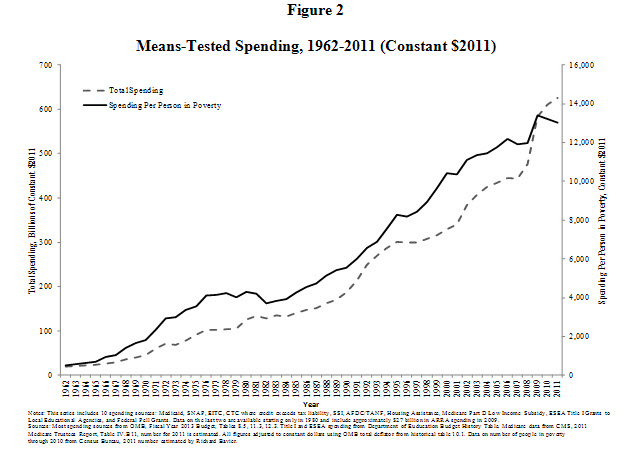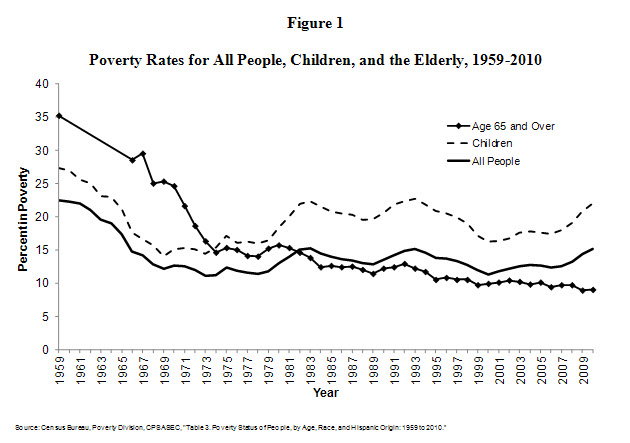Testimony by Ron Haskins of the Brookings Institute before the Congressional Finance Committee focused on poverty. He looked at causes as well as federal policies. See his testimony at: Ron Haskins Testimony
He begins by noting that little progress has been made in eliminating poverty and points to Figure 1:
Unsurprisingly, the number of people living at or below the poverty line has increased as the economy retracted.
He notes 5 explanations for poverty in America. I am paraphrasing here:
1. Not enough jobs for everyone who wants to work. That got more challenging with the Great Recession.
2. Wages at the bottom have not improved:
“In 2007, wages at the 10th percentile were about $8 per hour, more or less where they were in 1979 if inflation is taken into account. Working at this wage for 35 hours a week year round, a person would earn $14,560, $2,145 under the poverty level for a family of three. …. Thus, if wages do not improve at the bottom, all single parents with two or more children at or below the 10th percentile – and even many above the 10th percentile – will always be in poverty if earnings are their only income.”
3. Single-headed, female headed families–children are more likely to be in poverty.
4. Inferior education to compete in the global marketplace.
5. Immigration. Immigrants are more likely to be poor than non-immigrants (see lack of education and low wages mentioned above)
He concludes:
“Reflecting on these five major causes of poverty leads one to understand why it has been so hard for the U.S. to make much progress against poverty despite the proliferation of social programs and the substantial increases in spending (see below) since President Johnson first declared war on poverty in the mid-1960s. Declining work rates, stagnant wages, the rise of female-headed families, inferior education, and the arrival of millions of immigrants with poor education and low skills are little engines pushing up the poverty rate. Conditions in the U.S. virtually ensure high poverty rates because the underlying factors that cause poverty have remained very strong. Even so, the nation has done a lot to reduce poverty and has even achieved a few victories as we shall now see.”
He then goes on to talk about government programs that are “means tested”– programs designed to help those who income falls below a set level (poverty line or some equivelent). But before I share what he reported, I have to note that many of these programs are not intended to reduce poverty. They are intended to ameliorate the harm that comes from poverty. Providing nutrition assistance or health care will not end poverty: they will make sure that people have enough to eat (and that farmers continue to have consumers), and that people will not die because they lack the financial means to obtain care. These are noble goals and are necessary in a great society.
On to the means tested programs:
Trends in Spending on Means-Tested Programs
Haskins states: “Many analysts think that the nation could greatly reduce poverty by spending more money on programs for the poor. Figure 2, based on a Brookings analysis of federal budget data published by the Office of Management and Budget, shows that federal spending since 1962 in the ten biggest means-tested federal programs has increased dramatically. Since 1980, by which time all but two of the ten programs that spent the most money in 2011 were in place, spending has increased by about $500 billion, from $126 billion to $626 billion after adjusting for inflation. Similarly, spending per person in poverty between 1980 and 2011 increased from about $4,300 to $13,000 or more than $3 spent per person in poverty in 2011 for every dollar spent in 1980. More recently, means-tested spending increased from about $477 billion to $626 billion in the first three years of the Obama administration, an increase of about 31 percent.”
 Haskins acknowledges that much of the costs would have increased over time because there are more people in poverty. It should also be noted that for some programs, like food stamps, more eligible people have applied during the Great Recession; before that, many people who were eligible did not apply.
Haskins acknowledges that much of the costs would have increased over time because there are more people in poverty. It should also be noted that for some programs, like food stamps, more eligible people have applied during the Great Recession; before that, many people who were eligible did not apply.
From my perspecitve, the big problem with lumping all these programs together is the inclusion of Medicaid. Health care costs over time have consistently outpaced inflation. In addition, Medicaid has also become the payer of last resort for the elderly who find themselves in need of health care services beyond what they can afford (and Medicare does not cover), especially nursing homes and longterm care facilities. Clearly, no matter how much we spend on Medicaid, it will have zero impact on reducing poverty. It will ensure that people get needed health care though. But they are different things. The spending analysis should separate out those programs that are intended to reduce poverty–like education, skill training, job creation, work incentives–and those that are intended to be a safety net that provides some basic services like adequate nutrition and health care as a basic human right. Of course, giving people enough money so they are no longer in poverty is another option, but social security and SSI really do not that.
Still, Haskins does recommend giving people enough money:
“Strategy 1: Give Them Money
The most straightforward way to help people escape poverty, primarily when they belong to a group, such as the elderly or disabled, who are not expected to work is to give them cash and in-kind benefits that will bring their income above the poverty threshold. The Social Security program, for example, is designed specifically to help the elderly avoid destitution.”
What about other people?
“Strategy 2: Increase Work Rates and Work Supports
At the other end of the continuum from policies that give money and other benefits to the poor are policies that encourage work. Well over 75 percent of families with children that lack a full-time, year-round worker are in poverty.”
Here he focuses on women with children–and the lessons learned from 1996 welfare reform. It is a far from simple solution, but he underscores the idea that for many, wages will still be below poverty so other supports need to be in place to lift them out of poverty: EITC, SNAP, and Mediciad.
Among other strategies, he advocates policies aimed at reducing unmarried births and investing in education–including preschool programs like Head Start. For different reasons, these are likely to actually reduce poverty–although even these depend on a vibrant economy with sufficient jobs that pay a living wage to all who seek them.
